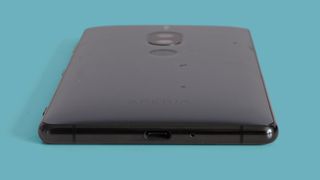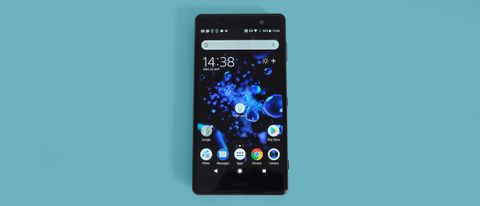Why you can trust TechRadar
Battery life
- Wireless charging
- 3,540mAh battery doesn't last long
The Sony Xperia XZ2 Premium has a 3,540mAh battery. That’s 360mAh more than the Sony Xperia XZ2, not a huge upgrade given the phone has almost 6,000,000 more screen pixels.
Sure enough, the phone performs poorly in our standard video test. 90 minutes of video at maximum brightness takes 30% off the battery.
This is radically more than the Samsung Galaxy Note 9 (12%) and Huawei P20 Pro (9%). However, it’s only slightly worse than the 27% loss of the Xperia XZ2.
This screen is power-hungry. However, its consumption becomes more ordinary at lower brightness. 30 minutes of Real Racing 3 at 50% screen brightness, for example, takes 11% off the battery. It’s a better result as running a 3D game should in theory be more taxing than playing video, even with reduced screen brightness.
While the phone doesn’t do well in our standard battery test, the Sony Xperia XZ2 Premium’s real-world stamina is at least passable.

After a full day it tends to have around 10-15% charge left by bed time. This is after several hours of audio streaming and the usual frequent flicks over to messenger apps.
Other phones at the price outlast the Xperia XZ2 Premium, then, especially the Huawei P20 Pro. But the phone does at least offer the minimum battery life we need to avoid getting annoyed.
Charging could also be faster, however. You do get a fast charger with the phone, but it takes (in our testing) exactly 2.5 hours to get it from 0% to full. The first 30% takes 22 minutes, and as usual the last 20% is much slower.
The Sony Xperia XZ2 Premium also supports wireless charging, if you’re keen on the idea.
Camera
- Dual rear 19MP/12MP cameras
- 13MP front camera
- 4K video recording
The Sony Xperia XZ2 Premium has the most interesting camera put into a Sony phone in ages. Top Xperia handsets tend to use very high-res sensors, but almost always worse processing, and hence final photos, than rivals. That is starting to change.
Two cameras sit on the XZ2 Premium’s back. One is a 19MP sensor with an f/1.8 lens, the other a black and white 12MP sensor with very large 1.55-micron sensor pixels.
There’s no ‘optical’ zoom here. The secondary camera is used to boost general image quality, particularly in low light conditions. Huawei used a similar concept: you use the greater native dynamic range and sensitivity of the black and white sensor to improve image quality, for results not possible with the single-color sensor.
This concept seems to work much better here than in Huawei’s older phones. Sony has often offered a low-light mode that makes night scenes bright, but they are generally low on detail.
The Sony Xperia XZ2 Premium can make night scenes look bright and clear, while retaining much more detail than older models.

It’s refreshing to review a Sony camera and not come away slightly disappointed. However, does it beat the best? The Huawei P20 Pro offers better dynamic range and detail at night, but it also takes several seconds to take a night image. Sony is much faster.
How about the Note 9? Its night images are slightly more detailed and less noisy than the Sony’s. We also noticed that in the most extreme conditions, when the Sony Xperia XZ2 Premium ramps up to its maximum sensitivity of ISO 51200, sometimes its color reproduction goes haywire.
The Sony Xperia XZ2 Premium can take excellent photos in daylight too, with punchy color, good dynamic range and detail. Once again, though, it doesn’t quite match up to the Samsung Galaxy Note 9.
Samsung’s top phones get you cleaner detail at pixel level. And as is usually the case with top Sony handsets, there’s some detail drop off in the very corners of the frame. Samsung gets you more consistent-looking shots.
However, the Sony Xperia XZ2 Premium is not miles off, and that’s a good result for a Sony flagship. In previous years Xperia phones have been miles behind.
There are some interesting little quirks to note too. For example, maximum resolution when shooting in ‘Auto’ is 17 megapixels rather than the full 19, which you can only use when shooting using the Manual mode. This crops into the frame a little, reducing the effect of the lens’s dodgy edges. Sneaky Sony.

There’s also a Bokeh mode, which uses the two cameras to let you blur out the background in photos. However, you can tell Sony hasn’t been perfecting this for years like Huawei and Samsung. It’s a little slow and you can usually see an outline around blurred and non-blurred objects. And the effect isn’t that dramatic.
Despite some real improvements this year Sony still has some catching-up to do.
Video is a rather different proposition, though. Phones like the Note 9 and Huawei P20 Pro only beat the XZ2 at night because they use optical image stabilization (OIS). This lets them use longer exposures, to improve image quality without drastically increasing ISO sensitivity.
Doing that makes images brighter, but also degrades the image.
OIS is less useful with video as the frame rate limits how slow the shutter can be anyway: if you need to take 30 or 60 frames a second, they need to be 1/30th or 1/60th of a second, max.
Sure enough, the Xperia XZ2 Premium’s low light video is much cleaner than the Note 9’s. However, we did notice some weird motion mess-ups in the background, which may be a result of the phone combining data from the two rear sensors.
Like the XZ2, you can shoot ultra-slow motion video at 960fps. Or less intensely slowed 120fps.
The front camera has a 13MP sensor. The results are pretty good: detailed even in muggy indoor lighting. And the phone can use the screen as a quasi-flash for better results.
Camera samples









Current page: Battery life and camera
Prev Page Introduction, key features and design Next Page Anything else I should know?Andrew is a freelance journalist and has been writing and editing for some of the UK's top tech and lifestyle publications including TrustedReviews, Stuff, T3, TechRadar, Lifehacker and others.

